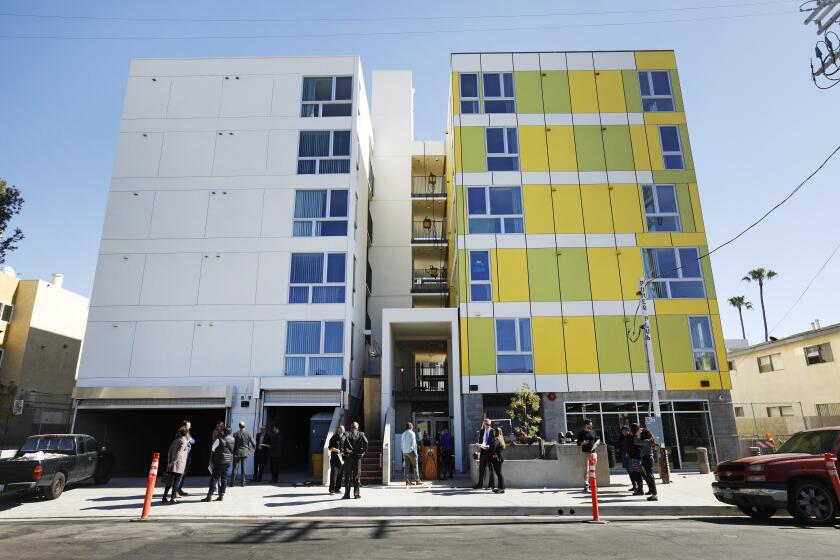Editorial: It’s time for a new conversation about L.A.’s future
For what may be a brief moment in Los Angeles, planning is hot. Measure S, the slow-growth, anti-development initiative, failed at the ballot box but succeeded in one very big way: It drew attention to the city’s broken land-use process and the need for a new comprehensive vision for how Los Angeles should grow.
Measure S forced city leaders and voters to confront the very real challenges facing Los Angeles, such as the lack of affordable apartments, homelessness, gentrification and how to manage the transformation of once-suburban Los Angeles into an increasingly urban city. There was near-universal agreement among proponents and opponents of “S” that the status quo isn’t working. Land-use rules are outdated and routinely ignored. Every new project is a political negotiation and a fight over height, density and community impact, making housing construction a high-stakes gamble and turning residents reflexively into NIMBYs.
Yet voters overwhelmingly rejected the solution offered by Measure S: a two-year construction moratorium on certain developments. Clearly, voters do not want to stop building. But what do they want built? Where do they want it built? And can Los Angeles finally fix this broken system that doesn’t produce enough housing, erodes public trust in government and doesn’t result in well-planned communities?
The answer is yes, but only if Mayor Eric Garcetti and the City Council embrace the opportunity created by the failure of Measure S. The initiative created a chance to have a transparent, inclusive and wide-ranging civic dialogue about how Los Angeles should grow and evolve.
Los Angeles as a whole needs to be far more walkable, bikeable and transit-oriented.
Yes, the mayor and council have committed to updating the General Plan and the 35 community plans, which set goals and rules for development in a neighborhood. Those are good long-term reforms, but they’ll take four to six years to achieve. In the meantime, all the urgency, advocacy and momentum for change spurred by Measure S will fade away, and Los Angeles runs the very real risk of repeating what it has done time and again: The city develops a plan for growth, homeowner groups oppose it, and then elected officials ignore it.
In the 1970s, Planning Director Calvin Hamilton developed the “Centers Concept” as the city’s official vision for growth in the General Plan. The idea was to concentrate denser development in regional centers — including downtown, Hollywood, Century City and Warner Center — and connect the centers with rapid transit, while largely leaving the surrounding suburban single-family neighborhoods alone. (The plan also called for creating more recreational space by turning flood control channels into streams and lakes, an idea that’s been revived with the Los Angeles River restoration project.)
But the rapid transit wasn’t built, in part because voters kept rejecting sales tax hikes to build rail lines. Real estate interests and City Council members largely dismissed the vision in favor of developing on a case-by-case basis.
The city revised its approach to growth in 1996 with the Framework General Plan, a name that told Angelenos absolutely nothing. The Framework said L.A. would channel most new development onto 5% of the land in the city, mostly dense commercial boulevards such as Wilshire, Ventura, Pico and Venice. In those targeted areas, the plan called for dense, walkable neighborhoods where shops and apartments would be mingled rather than separated as in suburban development.
It’s now 20 years later, and some of the ideas in the Centers Concept and the Framework are still relevant. For instance, it makes sense to concentrate growth in areas served by rapid transit and to mix residential and commercial development to reduce the need to drive for every errand. But Los Angeles as a whole needs to be far more walkable, bikeable and transit-oriented, with most communities within easy reach of frequent bus or rail service and amenities such as parks, libraries and grocery stores.
Since 2008 voters have twice approved sales tax increases for public transit. That money will help the county double the size of its rail network, as well as build more bus lanes, bike lanes and pedestrian projects, making it easier for people to get around without a car.
Downtown now has added thousands of apartments and condos, becoming a hub of 24-hour activity. And once-industrial parts of downtown like the Arts District are becoming residential neighborhoods. There are ambitious plans underway to restore the Los Angeles River and create a 32-mile swath of green space through the city. Recent elections — not only Measure S, but also the decisions in November to raise taxes to build rail lines and homeless housing, and to require affordable housing in certain new developments — suggest that Angelenos are open to a more urban city. So it’s time to take pulse of the residents again and start writing better guidelines for the future L.A.
Follow the Opinion section on Twitter @latimesopinion and Facebook
More to Read
A cure for the common opinion
Get thought-provoking perspectives with our weekly newsletter.
You may occasionally receive promotional content from the Los Angeles Times.










